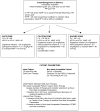Protocolized approach to the management of congenital diaphragmatic hernia: benefits of reducing variability in care
- PMID: 20620342
- PMCID: PMC3318997
- DOI: 10.1016/j.jpedsurg.2010.02.104
Protocolized approach to the management of congenital diaphragmatic hernia: benefits of reducing variability in care
Abstract
Purpose: Variable approaches to the care of infants with congenital diaphragmatic hernia (CDH) by multiple providers may contribute to inconsistent care. Our institution developed a comprehensive evidence-based protocol to standardize the management of CDH infants. This report reviews patient outcomes before and after the implementation of the protocol.
Methods: Retrospective chart review of CDH infants managed with individualized care (preprotocol group, January 1997-December 2001, n = 22) or on the protocol (Protocol group, January 2002-July 2009, n = 47). Survival and other categorical variables were compared by chi(2) analysis, and continuous variables were compared using 1-sided analysis of variance analysis, with significance defined as P < .05.
Results: Survival to discharge was significantly greater in the Protocol group (40/47; 85%) than the preprotocol group (12/22; 52%; P = .006), although mean gestational age, mean birth weight, and expected survival were not statistically different between the 2 groups. The use of supportive therapies, including high-frequency jet ventilation, inhaled nitric oxide, and extracorporeal life support, was similar between groups as well.
Conclusions: Since the implementation of a management protocol for infants with CDH, survival has improved significantly compared with expected survival and preprotocol controls. Reduction in the variability of care through use of an evidence-based protocol may improve the survival of CDH infants.
Copyright 2010 Elsevier Inc. All rights reserved.
Figures
References
-
- Clark RH, Hardin WD, Jr, Hirschl RB, et al. Current surgical management of congenital diaphragmatic hernia: a report from the Congenital Diaphragmatic Hernia Study Group. Journal of Pediatric Surgery. 1998;33(7):1004–9. - PubMed
-
- de Buys Roessingh AS, Dinh-Xuan AT. Congenital diaphragmatic hernia: current status and review of the literature. European journal of pediatrics. 2009;168(4):393–406. - PubMed
-
- Downard CD. Congenital diaphragmatic hernia: an ongoing clinical challenge. Current Opinion in Pediatrics. 2008;20(3):300–4. - PubMed
-
- Downard CD, Wilson JM. Current therapy of infants with congenital diaphragmatic hernia. Semin Neonatol. 2003;8(3):215–21. - PubMed
-
- Kays DW. Congenital diaphragmatic hernia and neonatal lung lesions. The Surgical Clinics of North America. 2006;86(2):329–52. ix. - PubMed
Publication types
MeSH terms
Substances
Grants and funding
LinkOut - more resources
Full Text Sources


